Juniors teams have either ended their season over the past 2 weekends, or are gearing up for the final push for Nationals. It might feel like there’s only so much you can do in the past couple weekends, but I’ll discuss a tool in the hitting toolkit that might be an instant upgrade for a few of your hitters.
But first, an announcement: I’m excited to announce a small-group workshop for this upcoming Monday, June 12, at 12pm ET, 9am PT. (Edit: June! June! This event is not taking place in the past…)
The workshop is with Nick Del Bianco and Mischa Harris of Athlete Wellness Academy aka The Canadian Armswing guys. One of the most common questions I get asked about at coaching clinics is, “how do I improve an armswing?” And there’s not a lot of great information out there. A lot of higher-level coaches have an opinion that’s closer to, “by the time they get to me, their armswing is pretty set and I don’t mess with it much.” In a previous workshop with Tayyiba Haneef-Park, we touched on this topic a bit:
Tayyiba Haneef-Park Talks Hitting Styles
This week we’ve been discussing Semi-System Offense. Monday was a discussion on how to evaluate and analyze it, and the Wednesday article outlined a simple drill for hitting armwork. I’m posting this Coaching Workshop I did with Tayyiba Haneef-Park last year, because she talks about a lot of things relevant to this topic. In In-System offense, I tend to think of the pasing and setting create fairly easy opportunities- the hitter just needs to finish the play. True Out-of-System situations are more about managing the game and giving yourself a chance in transition. But these Semi-System situations are where hitters with a well-developed toolkit can shine.
But I would say we talked more about differences in style and technique, especially between different international systems, rather than how armswings are formed. (Although she talks about that a little, check it out!)
So I’m excited to dive into more of the biomechanics end with Nick and Mischa. The most important part of this session is going to be this topic:
How can we bridge the gap between “weight room” and “technical instruction”?
Some of you who have talked with me about this topic know that I am a huge advocate of starting every practice1 with strength training and then moving directly on to the court, with the goal of improving movement patterns in a controlled setting (the weight room) and then transfer that into a team setting.
This is especially critical at the NCAA level. When I talk with college coaches, this is what I say to all of them:
Every college coach knows that jumping high and hitting hard wins games.
Every college coach falls all over themselves to recruit the players who jump the highest and hit the hardest.
But almost no college coach (a) tracks jumping ability and hitting velocity on more than an intermittent basis and (b) can tell me with any degree of accuracy how much they expect a player’s jump and velocity to improve in their 4 years of college.
Most coaches will devise drills where they’ll track passing, or study how well a player passes on their left v right. They’ll monitor improvement and probably give feedback to players on a daily basis. If you asked those players at a P5 school, “what are you doing to improve your passing, what’s the standard you’re trying to get to, and how much do you think you can improve toward that standard over the next year?” most of them could give a pretty good answer to that question.
But if you said, “what’s your spiking velocity, what’s the standard you’re trying to get to, what’s the improvement plan you’re on, and how much do you think you can improve toward that standard over the next year?” I think you’d get a less clear answer.
And improving attacking power 5% will likely translate to more wins than improve passing accuracy by 5%.
Alright, alright, rant over. But seriously, everybody get ready to check this session out. And here’s my request:
Comment on this article or respond to this email with a question you have about how to improve hitting power, armswing efficiency, and shoulder health.
We might touch a little on jumping, we have some stuff prepared for that, but I think the armswing stuff is going to dominate the discussion and I’d rather go deep into one topic than halfway touch two.
And, now on to the Toolkit:
Hitting Toolkit Part 3: The Pot Throw
Check out the 2 previous articles in this series:
Hitting Toolkit Part 1
Hitting Toolkit Part 2
Okay, so Nick and Mischa are going to talk to us about how to develop power and efficiency in our athletes over a long time period. But you need to win some games at Nationals, and that’s coming up soon. What can you do?
If you haven’t worked on Pot Throws with your left or right-side attackers, you might find that this is a tool in their toolkit that they can pick up fairly quickly and will lead to a few extra kills in certain situations.
Here’s a picture-perfect Pot Throw in a club match:
Just get a strong hand on the ball and throw it on into that pot!
Your more beach-oriented players might prefer to roll it into the pot:
I think most players tend to have a bit more control with the throw than the roll, but there’s nothing necessarily wrong with either one. The common mistake will be different between the two techniques though.
Throwers will tend to go too shallow. They’ll will “tip” it too high up over the block and then the ball will be landing too shallow. The line defenders and off blockers start to get a better chance at that ball that is arcing up too high. (Notice the flat trajectory of the above throw)
Rollers will tend to go too deep. There’s a fine line between rolling to the pot and rolling to middle back.
What you’ll notice that is common about these two clips is that the ball is not going way up over the block. Most players who tip or roll put the ball so high that it hangs in the air forever.
My cue for this is “throw at the branches.”
You’re totally fine if the ball clips the fingers of the blockers. Don’t bring it down into the tree trunks of the block! And definitely not down into the dirt of the tape. But right at the top of the branches and you’re in good shape. If they do manage to push it back on your side, it’s going to be a soft block and easy cover. If it clips the top of their block, it’s going to fall shallow and be a difficult defensive pickup. And if it clears the block, you want it to clear by less than a ball’s width so that it can get down on the floor faster.
And now, 2 clips from one of the masters, the great Betty De La Cruz:
That was actually a two-handed set right at the branches. Rather than swing right into a well-formed block or dink way over it, just put it right at the branches, be ready to cover, and sometimes pick up a favorable roll off the fingertips.
Here’s one where she’s a little more in rhythm:
Alright kids, just do that and you’ll be good.
And I’m talking about more advanced teams now (which could still be juniors), not beginners.

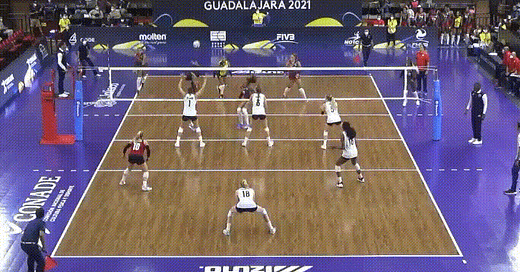

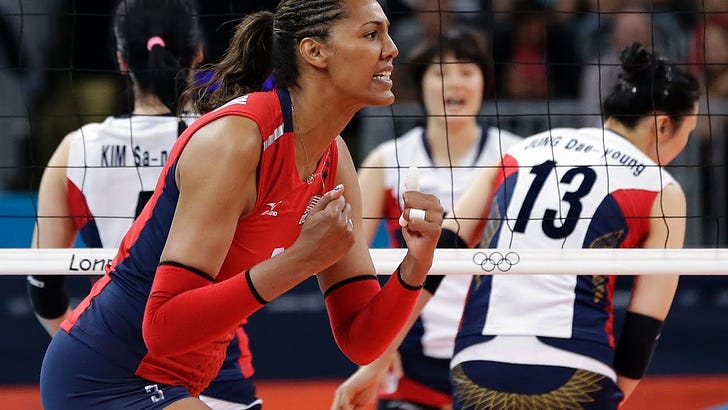
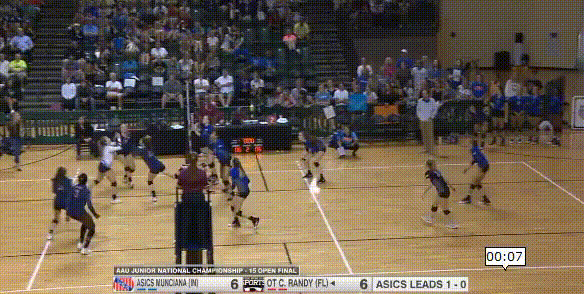
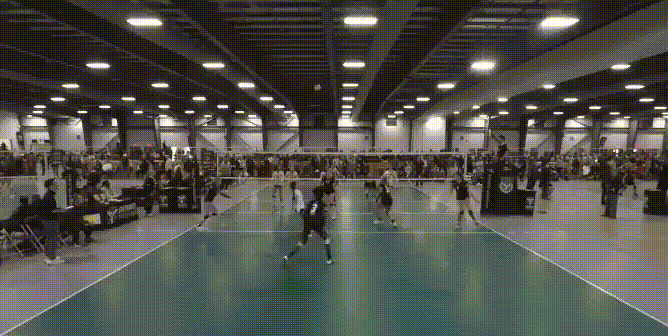
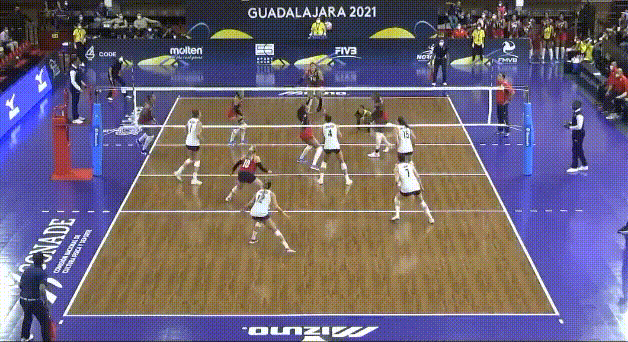

I coach High School Girls and Boys, the biggest issue I see on the girls side is the lack of scapular retraction. There are just some certain players that are great athletes but can’t pull their arm all the way back to maximize torque (maybe have never played softball or a sport where they needed to throw something). Due to playing so much club vball they develop some sort of swing with power but I see it results in back injuries or poor shoulder health, I am wondering if there is a way to help these players develop getting their shoulder back through specific excercises or drills that really isolate doing that, or how/what can I start doing at an earlier age with players so its not an issue down the road?
On the boys side every player can hit a ball pretty hard typically from the start and the shoulder is getting back, but the shoulder health issues I see is players using their arm as a “hammer” and not as much as a “whip”. These are the players who by senior year are coming to practice with shoulder soreness as opposed to kids with a more relaxed “whip” arm swing, is there a way to train that relaxed arm motion in a specific way?
With it it being summer and having extra practice time I feel like this is a great time to try things, would love to hear thoughts on this! Thank you!
Joe, May 12th? Or Jun 12th?